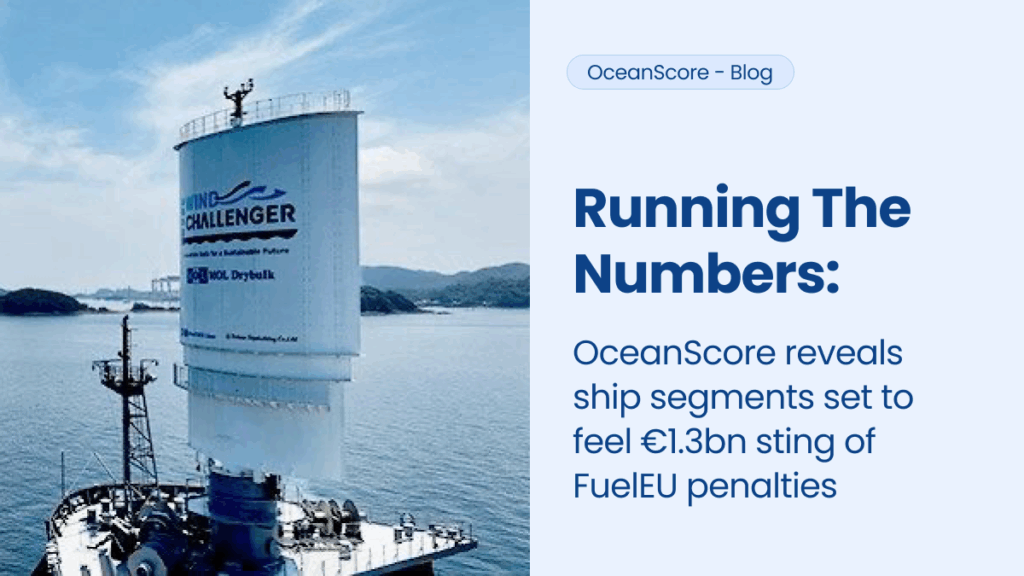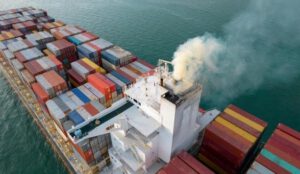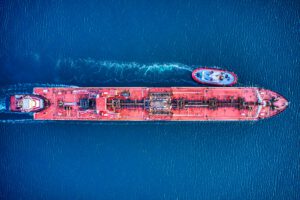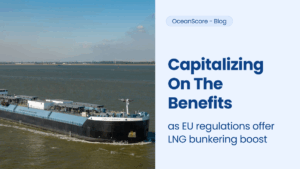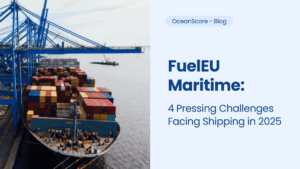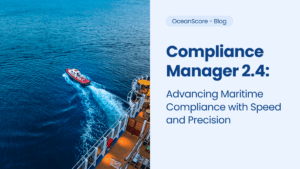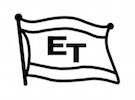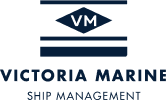The financial impact of FuelEU Maritime is focusing the minds of shipping companies as they face potential penalties for non-compliance with greenhouse gas (GHG) intensity reduction targets – and OceanScore has identified those segments set to be hit hardest.
Vessels in the passenger/cruise, container, RoPax, bulker and tanker segments will have significant cost exposure from the complex regulation due to be implemented from 1 January next year, despite a relatively modest initial target of a 2% cut in GHG intensity, according to OceanScore.
The Hamburg-based maritime technology firm’s data analytics team has calculated that shipping will rack up total FuelEU penalties of €1.345 billion in 2025 through analysis of the 13,000 vessels over 5000gt trading within and into the EU/EEA that are subject to the regulation. This is based on data on trading patterns and fuel mix from 2022 – the last full year currently available.
Containers bear burden
The team has been able to determine FuelEU compliance balances and resulting penalties for each vessel using OceanScore’s proprietary data modelling incorporating AIS data, Thetis emissions data, bunker intelligence and advanced analytics/AI. It has factored in the likely fuel mix for each vessel between EU ports and to/from the EU, as well as in ports.
Vessels will be hit with a penalty of €2400 per tonne of VLSFO-equivalent for failing to meet the initial 2% reduction target relative to a 2020 baseline for average well-to-wake GHG intensity from fleet energy consumption of 91.16 gCO2e per megajoule (MJ) – or emissions per energy unit. The GHG intensity requirement applies to 100% of energy used on voyages and port calls within the EU/EEA and 50% of voyages into and out of the bloc.
As with the EU Emissions Trading System (EU ETS), it is the container segment that will bear the brunt of FuelEU costs, accounting for 29% of gross penalties, followed by RoPax on 14% with tankers and bulkers each on 13%.
“It is critical for shipping companies to determine a baseline for expected FuelEU costs to secure proper planning and budgeting processes to compare different mitigation options, as well as to decide what to do with outstanding compliance balances,” says OceanScore Managing Director Albrecht Grell.
“This will require, to a higher degree than the EU ETS, a corporate strategy to determine how to reduce the compliance balance/deficit, how to commercialise a surplus and deal with deficits that remain.”
Wide spread of vessel liabilities
OceanScore has found that liabilities per vessel will differ widely across the various segments due to increasingly diversified fuel choices, including greater uptake of biofuels and LNG. Passenger vessels will be penalised the most with an average of €520,000 per vessel annually, followed by RoPax at €480,000 and RoRo at €314,000, with an average penalty for container ships of only €214,000, according to OceanScore.
Grell points out there are also massive discrepancies between vessels within these segments, with a number of ships in the passenger and RoPax segments exposed to penalties of between €1.8m and €2.5m, and payment obligations for some container ships approaching €1m. This is driven by higher energy consumption simply due to vessel size and trading profile.
While penalties will arise from so-called compliance deficits for vessels using conventional fuels, surpluses totalling an estimated €669m will be generated mainly by vessels fuelled by LNG and LPG with significantly lower carbon intensity.
LNG carriers will account for 78% of the total market surplus and gas carriers 8%, while a further 8% will be generated by container ships that have seen a modest uptake in alternative fuels in recent years.
Pooling can halve costs for the industry
Taking into account this estimated compliance surplus, the net cost of FuelEU penalties for shipping from 2025 would be €680m, which indicates that pooling of vessels can roughly halve the gross burden for the industry.
Penalties will, in segments typically using conventional fuels with comparable carbon intensities such as HFO, LFO or MDO, be roughly proportional to the overall fuel consumption, thus correlating with the EU ETS cost.
Initial costs of FuelEU for most conventionally fuelled vessels, prior to pooling, will be around one-third of those associated with the EU ETS next year when the latter regulation will have 70% phase-in. But ultimately FuelEU is likely to prove a much more costly affair as the requirement for GHG intensity cuts rises to 6% by 2030 and then accelerates to reach 80% by 2050.
“It is therefore incumbent on shipowners to define their strategies not only towards fuel choices and the use of onshore power but also towards handling of residual compliance balances such as pooling, banking and borrowing of balances, to mitigate the financial impact of FuelEU. However, pooling will also come at a cost, while banking and borrowing will incur interest costs and only push liabilities into the future,” Grell explains.
‘Sound administrative processes’
He further points out that pooling compensations paid between different shipping companies will effectively divert cash flow away from the EU that it would otherwise have earned from FuelEU penalties – but that this effect is intended by the regulator to “reward” early adopters of clean fuels.
Another factor that will curb potential income for the EU from this regulation is that the compliance gap has been reduced to only 1.6% by 2022, as average GHG intensity from shipping has come down by 0.4% to 90.82 gCO2e per MJ, mainly due to increased LNG carrier calls to Europe after gas supplies via pipelines from Russia were halted when the latter invaded Ukraine. Given this trend and increasing adoption of biofuels, the 2% compliance gap will probably be closed before the first tightening of reduction targets in 2030.
Grell says the priority for shipping companies, especially at this early stage while cost exposure is relatively low, is to get to grips with the complexity of the regulation and tackle the risks arising from the fact the party liable for penalties – the DoC holder, or possibly shipowner – is not the one responsible for emissions, which is typically the charterer.
“As well as having costs oversight, companies require reliable monitoring and reporting mechanisms with high-quality emissions data. They must also have in place complex contractual arrangements and sound administrative processes to manage compliance and mitigate the financial consequences of the new regulation,” Grell concludes.
For more information contact:
Candice Buckle, Marketing Manager, OceanScore.
Email: candice.buckle@oceanscore.com
About OceanScore
OceanScore is a maritime data analytics firm that specialises in providing advanced solutions for regulatory compliance and benchmarking of environmental performance, with offices in Hamburg, Poland, Portugal and Singapore.

